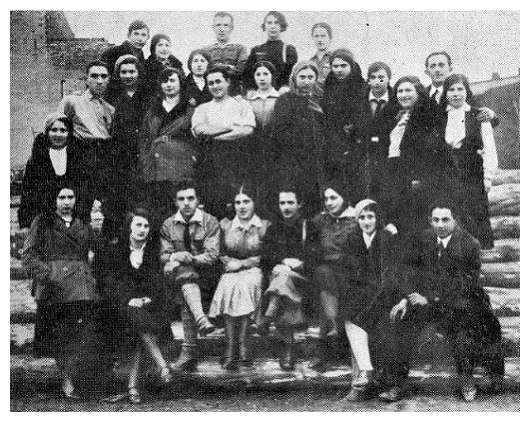
Members of the “HeChalutz” branch with members of the Hachshara group
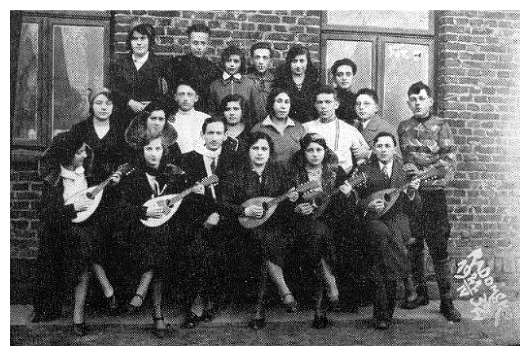
The members of the orchestra of the “Hapoel” branch with
members of the Hachshara group
|
by Hadassah Adar Moshe and Zelda Keren
Translated by Mira Eckhaus
It was in 1934, in the spring months, when I arrived at the training point in
Radomsko. Could I have imagined in those days that the steps I took in the
streets of this city would be so fateful in my life? Could I imagine in my mind
that the steps I took out of childish joy, and perhaps recklessness, would
determine the course of my life in the future? And they will save me from the
Holocaust and the killing that befell Israel's settlements in Poland?
Our group lived in the center of the city and I see in my mind our place of residence even today. The road to the city led along the railroad tracks and it was quite long, especially for those of our members who returned home after a hard day's work from their various places of work.
In that gloomy period when the Jewish youth wandered around in despair, the Land of Israel was the only bright spot in his life.
My stay in Radomsko was a profound experience for me. Here nature was revealed to me for the first time in all its glory – the field, the forest, the garden, and the forces of nature – the rain, the wind in their full meaning and roles in agriculture.
Near our residence was a private vegetable garden of one of the Poles. For the first time in my life, I tasted the taste of working in agriculture here. I weeded the weeds and lovingly nurtured the plants and flowers that grew in the garden. With all the warmth of my youth I clung to this foreign land and loved it with all my soul. To this day I carry with me the smells that intoxicated me then. My work in the garden was not included in my work schedule and I did it as a volunteer.
At that time, there were few jobs for members of the Hachshara (training). Unemployment prevailed in Poland at the time and the Jewish industrialists were not eager for Jewish workers. However, wealthy and generous Jews such as Farman, Gitler, Shapira, Kupershtuch, Hempel and others were found in Radomsko who were among those who were loyal to the Hachshara and its supporters. Thanks to them, our members infiltrated various workplaces such as a sawmill, an oil factory, and the like. The work in these factories was not easy and our members worked hard.
I worked in the Kupershtuch button factory. It was not one of the big factories and most of its workers were Christians who looked at me as an exceptional. The son of the factory owner was probably one of the fans of the Hachshara as he treated us kindly.
The remote corner outside the city, where we lived, soon became a lively and cheerful meeting place for the youth. Groups of young men and women appeared at our place every evening and a song full of enthusiasm and longing filled the air.
The residents of the city got to know the members of the Hachshara well and the Jews who were standing near their shops accompanied us with warm affectionate looks when we went to work and when we returned from it cheerful and happy.
The period of my training was short, but full of content and meaning and to this day I still think and remember those days with deep affection and with sincere excitement. Hadassah Adar (Degania B) * The period of my stay in Radomsko, in the Hachshara group, is deeply etched in my memory. It symbolized a turning point in my life and left its mark for many years.
It was a period of pioneering awakening among significant sections of the youth in Poland. Boys and girls from different places in Poland gathered in Radomsko. Their ambition was to train themselves for sharing and working life upon their immigration to the Land of Israel.
Life in the Hachshara was not easy. The transition from the comfortable life at my family's house to a life of a difficult manual labor, without all the convenience to which we have become accustomed, was above the forces of many of us. However, the majority adapted to the new conditions very well. The Hachshara period was at the time of a break in the Aliyah. The chances of a quick Aliyah were then slim and despair and disappointment often captured our hearts. We found encouragement and comfort then with the people of Radomsko.
Jewish Radomsko was proud of the Hachshara group that operated in the city. They treated us with a special care and did not leave us to deal alone with our daily difficulties and mental confusions. I would like to praise here the Schittenbergs, the Lehmans, the Eichners and the others, who accompanied us all the time and gave us their practical and moral help.

Members of the “HeChalutz” branch with members of the Hachshara group

The members of the orchestra of the “Hapoel” branch with
members of the Hachshara group
Moshe Keren (“Mishmar Hasharon”)
In 1933, I arrived to Radomsko to join the Hachshara and I found a nice, organized and established group there. In addition to teenagers, the group also included older members, who – as was explained to me – assisted it and served as liaisons between it and the residents of the city.
Already in the first hours of my arrival I felt myself in the group like a veteran member and that evening I visited the youth center with my new friends. I remember the cordial and warm welcome extended to us by the people of the city and the great help they gave us all the time we stayed in Radomsko in finding suitable working places. This help was important from a moral point of view no less than from a practical point of view. We were young, we just finished high school and left our parents' house and here, in the foreign city and among the foreign people, we found a cordial and warm atmosphere that eased the feeling of foreignness.
Radomsko was different from my native town of David Groduk in Pulsia, and it is this difference that made a strong impression on me. My town with its poverty, its meagerness and its inhabitants that were detached from the world around them, reminded me of the towns described in the writings of Mendeli and Shalom Aleichem. Radomsko was an industrial city with workers with class and national recognition.
The people of Radomsko became close to us and cordial relations of friendship were strengthened between us. They participated in every holiday and every important event in the group as our dear guests and we were their welcomed guests at the Jewish National Fund parties and the famous bazaars they organized and we contributed and helped to every cultural enterprise in the city. The youth also followed us and we rewarded them: we visited their clubs; We taught them Hebrew and the like.
My stay in the Hachshara and my meeting with the people of Radomsko are an important chapter in my life, because at that time the same mental powers were awakened in me which later helped me in my life.
Zelda Keren (“Mishmar Hasharon”)
by Yitzhak Hamer
Translated by Mira Eckhaus
The new winds of nationalism and socialism, which began to blow after the First
World War, did not pass over our city, which excelled in its adherence to
tradition. After the publication of the Balfour Declaration, the youth in
Radomsko started to organize themselves in national-left organizations and
sometimes also in non-national organizations. Even young people who studied at
the Beit Midrash, who had national ideas beating in their hearts, gathered and
decided to establish their own organization, which would stand against the wave
of freedom and apostasy that flooded the Jewish youth, including the youth in
Radomsko.
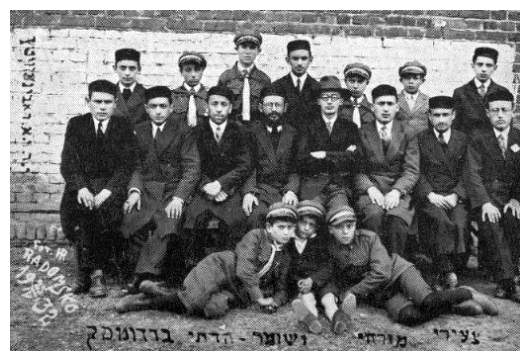
The members of “Tze'irei Mizrachi” (“Mizrachi”
youth)
and “HaShomer HaDati” (religious “HaShomer”) (1932)
First row above (from the right): A.Y. Stopnicki, —, Yerachmiel Strobinski,
—, Yohanan Eisen, Strobinski;
Second row: —, —, Getzel Ellenberg, Raphael Rappaport, Dr. Schulweiss (the center's
emissary),
Isaiah Eliezer Rabinowicz, Label Shmulewicz, Yitzhak Hamer, Fishel Weiss.
A long time before that, the “HaMizrachi” Histadrut which also
founded a “Mizrachi” school had already existed in our city, headed
by the activists Reb Avraham Moshe Waksman, Mr. Shlomo Neimark, Reb Mordechai
Rozencwajg, Salzman, Mendel Fischhof, Reb Herschel Tuchmaier, Reuven Lieberman,
Meirel Schittenberg and his sons Yechiel, Shlomo and Melech and others.
When the Histadrut of “Tze'iri Mizrachi” (“Mizrachi” youth) was established, it was headed by the dear yeshiva students Avraham Ze'ev Goldberg, Hillel Yudkevich, Yehoshua Elazar Rabinowicz, Yitzhak Shatzansky (the son- in- law of Reb Moshe Binyamin Lehman) and later also Avraham Penski.
“Tze'ire Mizrachi” organized cultural activities such as Bible classes, Talmud, scientific and Zionist lectures which were lectured by Shlomo Naimark, the educated Gershon Kokochinski, (the son- in- law of Zvi Tuchmaier and the son of Reb Shamai the melamed), Hillel Yudkevich, I. E. Rabinowicz, Getzil (the son- in- law of Ellenberg the baker) and others.
With the development of the pioneer movement in 1928, a religious pioneer movement and an organization of religious girls named “Bruria” were also established in our city. The “HeChalutz Mizrachi” was headed by the members Raphael Rapoport, Yitzhak Shatzotzky, Fishel Weiss Yitzhak Hamer, Label Shmulewicz, Peshrovsky and others.
The establishment of the organization of the religious girls “Bruria” provoked a lot of opposition in the circles of the association, who conducted a campaign against it among the religious residents of the city. We saw in this organization great importance and a means of rescuing girls from religious families for the sake of religious Zionism – and we were not deterred by the many difficulties that stood in our way. “Bruria” organization was headed by Chaya Goldberg, Sarah Kornberg, Tiberg, Afman and others.
At the same time, a sports organization called “HaShomer HaDati”
(religious “HaShomer”) was established, headed by the members
Yerachmiel Strobinski, Raphael Pahchiaz, Esther Shmuelevich, Yitzhak Krakowski,
Yerachmiel Rosen and others.
[Page 197]
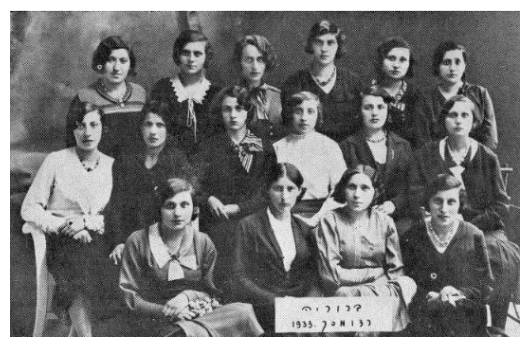
Members of “Bruria” organization (1933)
First row above (from right): Buchschreiber Tzipora, Ofman, Goldberg,
Second row: Liberman Adela, Kornberg, Shklarchik, Grosman, Epstein, —,
Landes Chaya, Ofman, Norman Sarah
Below:—, —, Goldberg Leah, Ofman
The Mizrachi youth organizations: “HeChalutz HaMizrachi”,
“Bruria”, and “HaShomer HaDati” have developed extensive
action in all areas of Zionist and cultural life in our city, such as actions
for funds, the Shekel, participation in elections, organization of lessons in
Hebrew, Bible, Geography, etc. Also, many members were sent to training points
(Hachshara) of the “HeChalutz HaMizrachi” and the girls were sent to
“seamstresses” Kibbutz in Warsaw.
by Yaakov Stein
Translated by Mira Eckhaus
I do not intend to provide here an exhaustive overview of TAI and its
operations since its formation in Radomsko. During the formation period, I was
not yet among those who took part in TAI's operations, therefore history will
not be written here, but a denotation of TAI's operations in Radomsko several
years before the Holocaust.
The duty of the organization
We had a period of longing for ideals, and as ambitions they wanted to go out into space. In the Jewish Street, the influence of socialism was felt and similar theories and all kinds of ideals that were foreign to the spirit of the people of Israel through the ages, became common. The youth who finished their studies in the “cheder”, and those whose parents' difficult living conditions forced them to abandon to Torah studies and start working, began to engage in various crafts that left their mark on the soul and spirit. In order to educate the youth to Judaism and to find a solution to their problems, it was necessary to organize them within the framework of an orthodox youth movement, such as the movement “Agudath Israel”.
The organization
In 5694 (1934), when a number of yeshiva students returned to Radomsko after years of exile in various places, they were called to an assembly of the activists of “Agudath Israel” and the TAI in order to revive the TAI movement, which was not active for years in the territories where it was necessary to act. At the assembly it was emphasized that the current situation is intolerable and that there is a necessity to reorganize TAI from the beginning and start educational and social activities. A temporary committee was elected: Yechezkel Rozencwajg, Chaim Batshan, Binyamin Akranat. Yaakov Zandberg served as the chairman, Yaakov Stein as the secretary, and Rabbi Tuvia Buki, may God avenge him, as the honorary chairman. Afterwards, they started with the organizational activities and members' registration. Gemara and Dinim classes were then held, which were given twice a week by Rabbi Tuvia Buki. In addition, lectures were given on topics that were of interest to the youth who began to integrate into real life. In a short time, the movement was established and a large club was rented which made it possible to expand the organizational and social activities. Every Shabbat, a prayer with the participation of the members and also of the ultra-Orthodox of the city, who came specially to help strengthen the movement, was held. At the “Seuda shlishit” (third meal), a party was organized with the participation of all the members, and Torah words from the week's parasha were said by the members, with each one spicing up his words in his own ideas.
Press
At that time, they made sure to distribute Agudath Israel's daily newspaper
“Dos Yiddishe Togblat” (The Yiddish daily) as well as the weekly
newspapers and all the other literature that appeared on behalf of TAI. The
ambition was that every ultra-Orthodox home would have the movement's
newspaper. It was not an easy task to influence ultra-Orthodox Jews to buy a
newspaper every day, because back then, there was no importance to the daily
newspaper for ultra-Orthodox Judaism. Only thanks to the dedication of TAI, the
circulation of the newspapers increased.
[Page 198]
The activities of TAI
In all the essential matters of the organized ultra-Orthodox Judaism in Radomsko, TAI acted as a pioneer passing ahead of the Torah wing. Whether it was in matters of education and mutual aid, or during elections to the Sejm and to the municipality – in which Agudath Israel participated actively. Thanks to the propaganda conducted by TAI, Reb Yitzchak Shapira, who worked there a lot to help Jewish institutions in general and Torah institutions in particular, was elected as the Agudath Israel's representative for the municipality.
However, mostly during the elections for the community, the youth organized in the TAI saw it as a sacred duty to conduct propaganda, so that the community would be run by activists from ultra-Orthodox Judaism. They fulfilled the verse “it's time of doing things to God”, and even the yeshiva students went to the houses of the people of Israel to explain the importance of the determination who will manage the affairs of the community, under whose authority are all the religious services of the city that are essential to ultra-orthodox Judaism. And indeed, for almost the entire period, the community was mostly run by ultra-orthodox.
The actions for the Land of Israel
In the year 5695 (1935), the national conference of TAI was held in Warsaw. Delegates to this conference were also sent from Radomsko, who were Chaim Lehmann (now lives in Canada) and Yaakov Stein (now lives in Haifa). At that conference it was decided, among other things, that the Land of Israel trend cannot be expressed only in the collection of funds for the “keren Hayishuv” (settlement fund), which was announced by “Agudath Israel” and in the “HaMillion” fundraising that the majority of the members devoted themselves to its actions. Actions were required for training and immigration to Israel. At a general meeting of the members, the delegates gave a report from the conference, and a debate ensued in which all the members who demanded to organize training places and prepare to immigrate to Israel participated. A committee was then chosen to start the actions that were decided upon at the conference. The branch in Radomsko, in cooperation with the branches of the surrounding area, organized in 5695 “Hachshara” for immigration to the Land of Israel in Kaminsk (place of the well-known summer day camp near Radomsko). A number of members from Radomsko also traveled to Hachshara in Kaminsk. The committee also made sure to increase the collection of funds for the “Keren Hayishuv” (settlement fund) by distributing the boxes in every ultra-Orthodox home and collecting them every month, as well as arranging lotteries. The success of the fund-raising campaigns that were organized in Radomsko, was thanks to the dedication of TAI and the active participation of the girls of “Agudath Israel” who, apart from all their blessed actions, worked for the affairs of the Land of Israel in an exceptional way. That time, several members of Aguda decided to immigrate to Israel with their families. And indeed, many families immigrated to Israel, in all kinds of ways. (Not with certificates, because they did not go to Hachshara but rather immigrated to Israel with all their family members). Among them were the late Reb Mordechai Bougier and his family, Reb David Nomberg and his family, Reb Moshe Binyamin Lehman and his family, Reb Moshe Kirsh and his son-in-law and his family, the Rozencwajg family, Reb Yaakov Eliya Rozencwajg and his family, Reb Avraham Lieberman and his family and others.
The bank
Among the many actions that Agudath Israel has done for ultra-Orthodox Judaism in Radomsko, we should mention the glorious bank that was founded in 5693, at the initiative of activists and tradesmen such as Reb Nachum Ivshitz, Reb Yitzhak Shapira, Reb Yaakov Grichter, Reb Wolf Frank, Reb Shalom David Wertheim, Reb Shmahya Krakowski, Reb Moshe Dudstein and Reb Avraham Grosman. The bank was headed by Reb Yosil Berger as manager, and Reb Moshe Wollhendler as cashier. It is worth noting that at the beginning of its establishment, the bank served as a unique institution that helped hundreds of members to establish their livelihood with the help of first constructive loans which were distributed to everyone without exception. The bank earned a good name among the other financial institutions of our city, in its efficient work for the ultra-Orthodox public who could not, for various reasons, be a member of other banks. In the last years before the Holocaust, it remained the only Jewish bank in our city who worked for the benefit of all the Jews of our city without exception.
To conclude my words, I would like to engrave in memory, a nice operation that was conducted by several cobblers of our city Radomsko for many years.
Every two weeks, on Mondays of the week, a market day (Turk) was held in Plavna near Radomsko. On that day, artisans from the surrounding towns would meet to sell their products, including the cobblers of Radomsko and Amstov (near Częstochowa). Since in the yeshiva of the Rabbi of Amstov, may God avenge him, many boys from Radomsko studied, the cobblers from Radomsko delivered packages given to them by the parents of the students who studied in Amstov and gave them to the cobblers of Amstov, so that they would deliver the packages to the yeshiva students from Radomsko. The same operation was also carried out in the opposite direction, the boys who studied in Amstov handed over their personal parcels to the cobblers from Amstov, and they took the parcels to the market day in Plavna, and delivered them to the cobblers in Radomsko. And that's how the parcels arrived to the parents of the students in Radomsko. Apparently, it seemed like a small and worthless thing, but for us, who were far from our parents and home, it was a great experience to receive a parcel from home, which included, among other things, fresh pastries, and we felt as if we were at home with our parents.
Those packages that the cobblers delivered to us, removed the necessity of devoting the precious time of a yeshiva student to the care of cleaning the clothes and all the other necessary things that our dear parents sent us. The importance is also in the fact that those artisans did their work out of desire and dedication, to make life pleasant for us in the yeshiva. This was not done in order to receive a reward, but, as they expressed, out of a desire to be among those who help the Torah. They were happy that they could help yeshiva students.
A decisive period has passed in the destiny of the people of Israel. The troops
of the tyrant, damn him, flooded Poland and exterminated the Jews. This fate
also befell our holy community. In it, our dear, innocent and honest friends
were also exterminated. In the mercy of God, a remnant remained, and the scroll
was not the end on everything. We, those of us who survived, will cherish their
memory in our hearts as they were, for in their death they commanded us life.
May their memory be forever.
by Bella Shaya
Translated by Mira Eckhaus
You may think that Radomsko was just a town like all the other towns. But it
seems to me that it was a one-of-a-kind town.
Radomsko was a typical Jewish town, juicy and full of Jewish grace, with its synagogue and its shtiebels and with the “Shabbat Goi” who came on Shabbat to light the ovens.
Among all the related actions done for the benefit of the community by various
public entities, the group of the girls of Agudath Israel's was particularly
noticeable, who fulfilled an educational and social mission among all levels of
the population. I would like to mention here in particular several dear figures
who stood at the center of these actions and with their dedication breathed
life into the children of Israel.
[Page 199]
Who did not know Sarah Buchner, a teacher at the “Beit Yaakov”
school. She was a famous figure among the Jews of Radomsko, she was short,
with a pale face and only her black and fiery eyes, that penetrated to the soul
of every child, were full with the content of life. Her work was tireless and
she instilled in us the recognition of the importance of action for the benefit
of the individual and the whole. She planted in our hearts an enthusiasm for an
original Jewish life and taught us to know the areas in which a Hebrew woman
can benefit from her talent; She showed us a whole world – a world of joy
and sorrow. She directed our talents to the beneficial channels of others. I
remember one social action that was hugely appreciated.
We established an evening club for the poor children there, where the children received a hot dinner every evening. We helped the children prepare their homework and also took the trouble to dress them properly. Our heart trembled with sadness and joy at the same time, when we did all this without any outside help, all by ourselves. We obtained the money to finance the operation in a very original way; The whole group would gather once a week to work together on knitting, sewing, etc., and the proceeds were used to cover the expenses of the aforementioned operation. We also organized evening classes with the help of a group of instructors; one of the gifted instructors was Regina Goldberg from Radomsko; With her unusual talents and energy, she instilled in us with Torah and Science. Her lessons in world history were especially interesting, she penetrated the heart of the female students and was liked by them all. Of the senior group of Agudath Israel girls, only one remained, the rest perished in the extermination camps and they deserve to be commemorated in an Yizkor book.
The tender and gentle Henia Rapoport found a field of action among the poor girls in Radomsko. Recently, she also served as a teacher at “Beit Yaakov”. Esther Wollhendler, Ruth Luria, Faiga Frank, Chava Zielonka, Pradel Wrochlawski and Pearl Botzen.
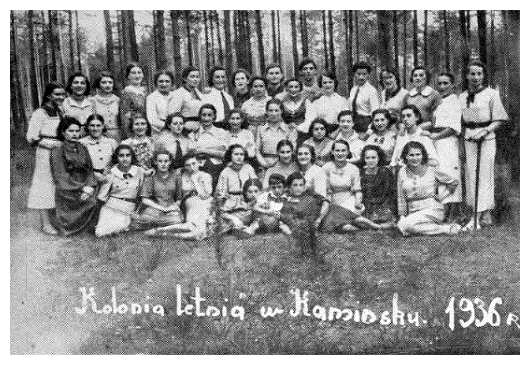
Agudath Israel girls' summer camp (1936)
by Yechezkel Grosman
Translated by Mira Eckhaus
As a teenager, a high school student, imbued with national-Zionist recognition,
ripe for organizational activity, I willingly and enthusiastically grasped the
offer that came to me from a group of veteran entrepreneurs (David Meir
Kornberg, Haim Hartman, Shifra Wittenberg, Paula Fireman and Mania Shapira) to
organize a learning youth group by the Jewish National Fund. For the first
meeting, I was able to bring 12-15 teenagers to the Jewish National Fund club
(in Hempel's house), mainly female students of the trade school who made up
almost all of the Jewish students in this school. The high school named after
Mrs. Weintraub was represented by Issachar Minsky, who announced that for
certain reasons the other members from his school could not come this time, but
would participate in the future. However, these did, in fact, participated
afterwards, and the students of the trade school formed the main nucleus of the
circle until it was disbanded.
The activities of the circle were conducted mainly in the Zionist educational area: fundraising for the Jewish National Fund, trips, training (hachshara) in the city, etc. I joined the work at the Po'alei Zion library, that was located on Przedborska Street named after the writer Shalom Aleichem (Shul Gas) and I enjoyed its high level.
However, only an innocent boy could hope that a non-partisan Zionist youth group will last for many years. The educators of the circle as well as its organizers attracted the members to the various party organizations that were active in our city at the time. The “Zionist Youth” arose almost exclusively from the expatriates of our circle. The other organization that benefited from the “looting” was “Gordonia”. I joined “Beitar”.
The Jewish party activity in Poland in the 1930s, to the extent that it was intense and diverse, was also full of contradictions and frictions that kept getting worse. A boy who joined Beitar and at the same time innocently continued to work in the Po'alei Zion library or in the Jewish National Fund committee, soon realized he was unwelcome in these institutions and was forced to leave them.
What was the spirit that blew in the revisionist camp in the thirties in Poland? The goal of the movement was defined as the aspiration for a Jewish state, while this slogan was not yet common among the other Zionist organizations. The youth were enchanted by the variety of slogans such as: Malchut, Hadar, Ben-Melech, Magal and Magen, but these were in terms of a vision. The more physical goals were: learning the Hebrew language, hachshara (training), Aliyah. However, in the territory of Aliyah, the chances of the members of Beitar are fewer, which added to the contradictions and bitterness and weakened the organization.
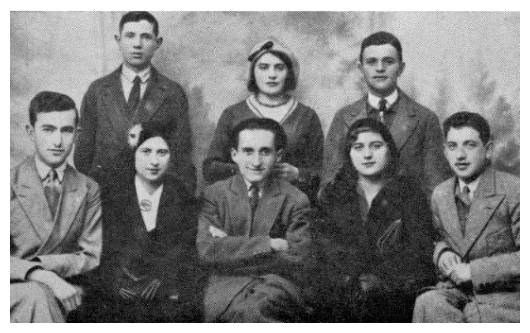
A group of members of Beitar and the Revisionist Zionist Alliance (1930)
Standing (from the right): Meir Mortenfeld and his sister;
Seated: Daniel Eichner, Yaffa Zilberberg, Y. Unger (the center's emissary),
N. Markowitz (lives in Belgium), Y. Rosenbaum (lives in the USA)
Among the first members of the Revisionist Zionist Alliance were: David Erlichman, (the teacher) Hillel Zumbek, Yosef Rosenbaum, Hartman, Daniel Eichner, Putschwitz, Zilberberg, Gil and others. The party represented the movement in different periods in the municipality, in the community and in various institutions, and was active mainly during the various elections.
One of the first commanders of Beitar was Erlichman Jr. During the successful
period, the number of Beitar members reached one hundred. The Brit Yeshurun
was organized at a later time and its actions were similar to those of Beitar,
but the religious tone was preserved there.
|
JewishGen, Inc. makes no representations regarding the accuracy of
the translation. The reader may wish to refer to the original material
for verification.
JewishGen is not responsible for inaccuracies or omissions in the original work and cannot rewrite or edit the text to correct inaccuracies and/or omissions.
Our mission is to produce a translation of the original work and we cannot verify the accuracy of statements or alter facts cited.
 Radomsko, Poland
Radomsko, Poland
 Yizkor Book Project
Yizkor Book Project
 JewishGen Home Page
JewishGen Home Page
Copyright © 1999-2024 by JewishGen, Inc.
Updated 18 Jun 2023 by OR